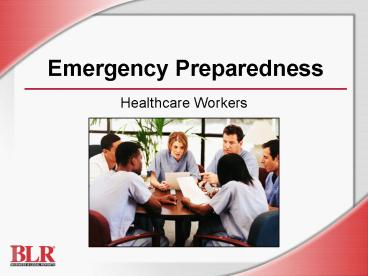Emergency Preparedness PowerPoint PPT Presentation
1 / 28
Title: Emergency Preparedness
1
Emergency Preparedness
- Healthcare Workers
2
Session Objectives
- You will be able to
- Identify workplace hazards that could cause an
emergency - Report emergencies promptly
- Carry out emergency responsibilities
- Evacuate quickly and safely
- Respond to emergency situations effectively
3
What You Need to Know
- Workplace hazards that could lead to an emergency
- How to report emergencies
- Emergency responsibilities
- Evacuation routes and procedures
- Response to fires and chemical/biohazard
emergencies
4
Are You Prepared?
- How would you react to a fire alarm?
- What would you do in a natural disaster such as a
violent storm? - Do you know your role if there were a serious
chemical or biohazard incident? - How would you respond to an act of violence?
5
OSHA Requirements
- Evacuation and exit routes
- Alarm systems
- Protective measures
- Training
- Emergency action and fire prevention plans
6
Types of EmergenciesYou Could Face
- Fires and explosions
- Chemical and biohazard incidents
- Natural disasters
- Violence
7
Fire Hazards Electrical
- Overloaded electrical systems
- Damaged wires and cords
- Damaged plugs
- Defective equipment
8
Fire Hazards Flammable Chemicals
- Dont smoke around flammable chemicals
- Store flammables properly
- Dispense flammables properly
- Read MSDSs and labels
9
Fire Hazards Smoking And Housekeeping
- Smoke only in designated areas
- Make sure cigarettes and matches are completely
extinguished - Keep your work area clean and neat
- Properly dispose of fire hazards such as
combustible trash
10
Chemical Release Hazards
- Look for signs of chemical spills
- Report leaking containers immediately
- Dont attempt a cleanup unless you are trained
and equipped
11
Biohazards
- Contagious diseases
- Infectious microorganisms in laboratories
- Foodborne illness
- Mold
12
Natural Disaster Hazards
- Flooding
- Tornado
- Hurricane
- Earthquake
13
Violence Hazards
- Workplace violence
- Civil disturbance
- Terrorist acts
14
Hazard Identification
- Do you understand the information that has been
presented so far?
15
Be Prepared to Respond Effectively to Emergencies
- Find out what you need to know now
- Prepare yourself to act correctly
- Participate in emergency drills
- Become familiar with emergency plans and
coordinators - Keep emergency exits clear
16
Know How to Report an Emergency
- Location of alarm boxes
- How to activate them
- Who to call
- What to report
17
Understand Emergency Responsibilities
- Handle only tasks youve been assigned and
trained for - Understand exactly whats expected of you
- Carry out responsibilities only if you can do so
safely
18
Patient Evacuation Responsibilities
- Understand a patients condition before moving
- Know specific patient removal procedures
- Be able to locate assigned safe areas inside or
outside the facility
19
Know Your Evacuation Route(s)
- Have at least two escape routes from your work
area - Know where emergency exits are located in other
parts of the facility - Know where to go for roll call once safely outside
20
Be Familiar with Evacuation Procedures
- Recognize the evacuation signal and listen for
instructions - Alert co-workers and patients
- Shut down equipment
- Go directly to the nearest safe exit
21
Evacuation Procedures (cont.)
- Move quickly but calmly
- Follow directions from emergency response
personnel - Proceed to the assembly area
- Do not leave the area until instructed
22
Notification and Evacuation
- Questions?
23
Respond Safely to Fires
- Remove yourself from danger
- Trigger the alarm
- Retrieve a fire extinguisher
- Call for additional help
- Continually evaluate the situation for the
necessity to evacuate - Dont try to fight large, spreading fires yourself
24
Fire Response Extinguishing Systems
- Portable extinguisher
- Fire hose
- Fire suppression systems
25
Fire ResponseExtinguisher Types
- AFor combustibles such as trash, wood, or paper
- BFor flammable liquids or gases
- CFor electrical fires
- ABCMultipurpose
26
Fire Response Extinguisher Use
- Pull the pin
- Aim at the base of the fire
- Squeeze the trigger
- Sweep back and forth
27
Respond Safely to Chemical/Biohazards
- Evacuate the area
- Shut doors and windows
- Notify a supervisor or the emergency coordinator
immediately - Remove ignition sources (if safe to do so)
- Do not return to the area until instructed
28
Key Points to Remember
- Fires, chemicals/biohazards, natural disasters,
and violence can cause workplace emergencies - Be sure you know evacuation routes, emergency
procedures, and emergency responsibilities - Ask if you have questions about emergency
preparedness dont wait for a real emergency

